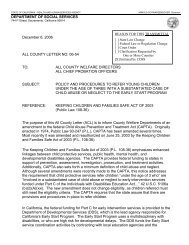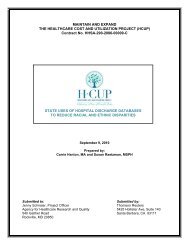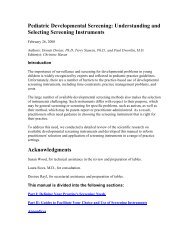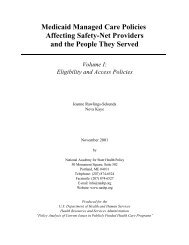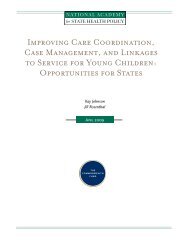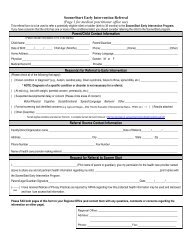Developing Federally Qualified Health Centers into Community ...
Developing Federally Qualified Health Centers into Community ...
Developing Federally Qualified Health Centers into Community ...
Create successful ePaper yourself
Turn your PDF publications into a flip-book with our unique Google optimized e-Paper software.
three sites, which means that the organizations are well positioned to leverage each<br />
other’s resources.<br />
<strong>Community</strong> <strong>Health</strong> Partners has used either its own operational funds or secured<br />
grant support to implement other kinds of services needed in its community, including:<br />
• a telemonitoring program for homebound patients that transmits a patient’s blood<br />
pressure level, pulse oximetry, and weight to the care manager;<br />
• a <strong>Health</strong> Check Coordination Program that supported two coordinators to identify<br />
children up to age 5 who are eligible for Medicaid and then educate their parents or<br />
guardians on the importance of regular preventive care; and<br />
• the Assuring Better Child <strong>Health</strong> and Development Program that works with practices<br />
to introduce and integrate a standardized, validated screening tool that supports the<br />
healthy development of young children up to age 3.<br />
Role of Care Managers<br />
About 75 percent of each network’s budget is dedicated to care managers.<br />
Practices are assigned a network-based care manager who provides patient education,<br />
medication compliance and reconciliation services, and, in the words of one private<br />
primary care provider, ―all the legwork needed to ensure improved care continuity and<br />
patient management.‖<br />
At <strong>Community</strong> <strong>Health</strong> Partners, care managers typically work with two to eight<br />
practices each, depending on the number of Medicaid patients. Together, they manage the<br />
care of about 4 percent of the Medicaid population assigned to their network. Care<br />
managers may move around between small practices or base themselves in a larger<br />
practice. They meet with patients at practices or hospitals, in their homes, or other<br />
locations as needed. Care managers have in-person consultations with providers and have<br />
become valued members of the care team. <strong>Community</strong> <strong>Health</strong> Partners also employs two<br />
care managers who concentrate solely on ensuring patients make smooth transitions from<br />
the hospital to their homes or other care settings. They communicate across the network<br />
when a patient is ready for discharge.<br />
Relationships with Private Providers<br />
A nurse practitioner in a small, private pediatric practice reports that practice staff<br />
develop strong working relationships with the care managers because each practice is<br />
assigned one. These relationships function through face-to-face meetings, regular phone<br />
calls, and e-mail. This particular pediatric practice has a high Medicaid population (90<br />
16



